John Lewis Partnership UK: An Analysis of the Business Environment
VerifiedAdded on 2024/05/30
|14
|4268
|440
Report
AI Summary
This report provides a detailed analysis of the business environment of the John Lewis Partnership in the United Kingdom. It explores various organizational structures, including public, private, and voluntary sectors, and their interrelationships within the macro business environment. The report discusses the scopes and sizes of different organizations, their functions, and their association with the organizational structure. It uses contemporary examples to illustrate the positive and negative influences of the business operation representing the macro environment, focusing on the internal strengths and weaknesses of specific business types and their interaction with external macro factors. The report also examines the merits and demerits of interrelationships between organizational functions, such as specialization, operational accuracy, speed in operation, segregation, and lack of coordination, providing a comprehensive overview of the factors influencing the John Lewis Partnership's business operations.
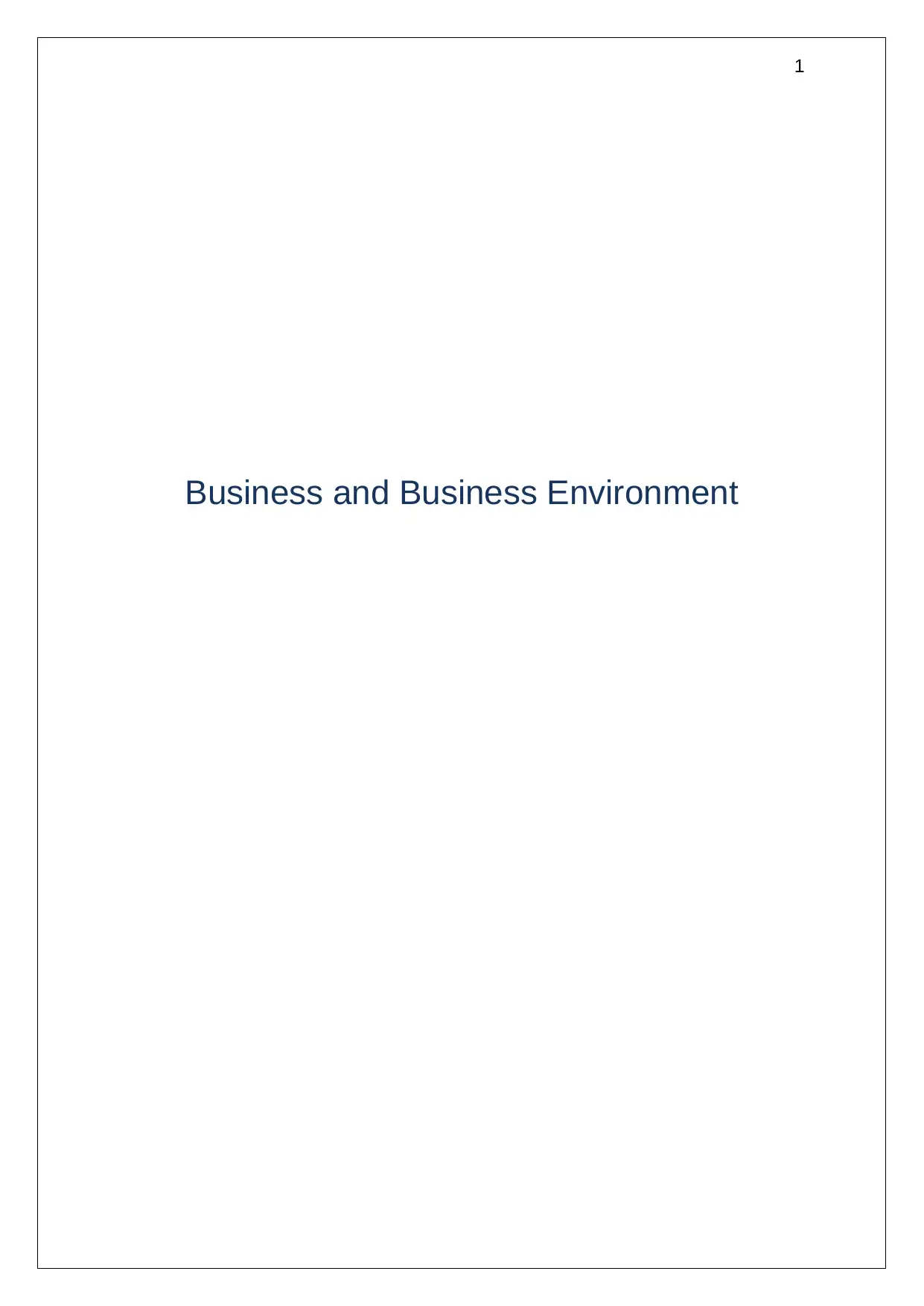
1
Business and Business Environment
Business and Business Environment
Paraphrase This Document
Need a fresh take? Get an instant paraphrase of this document with our AI Paraphraser
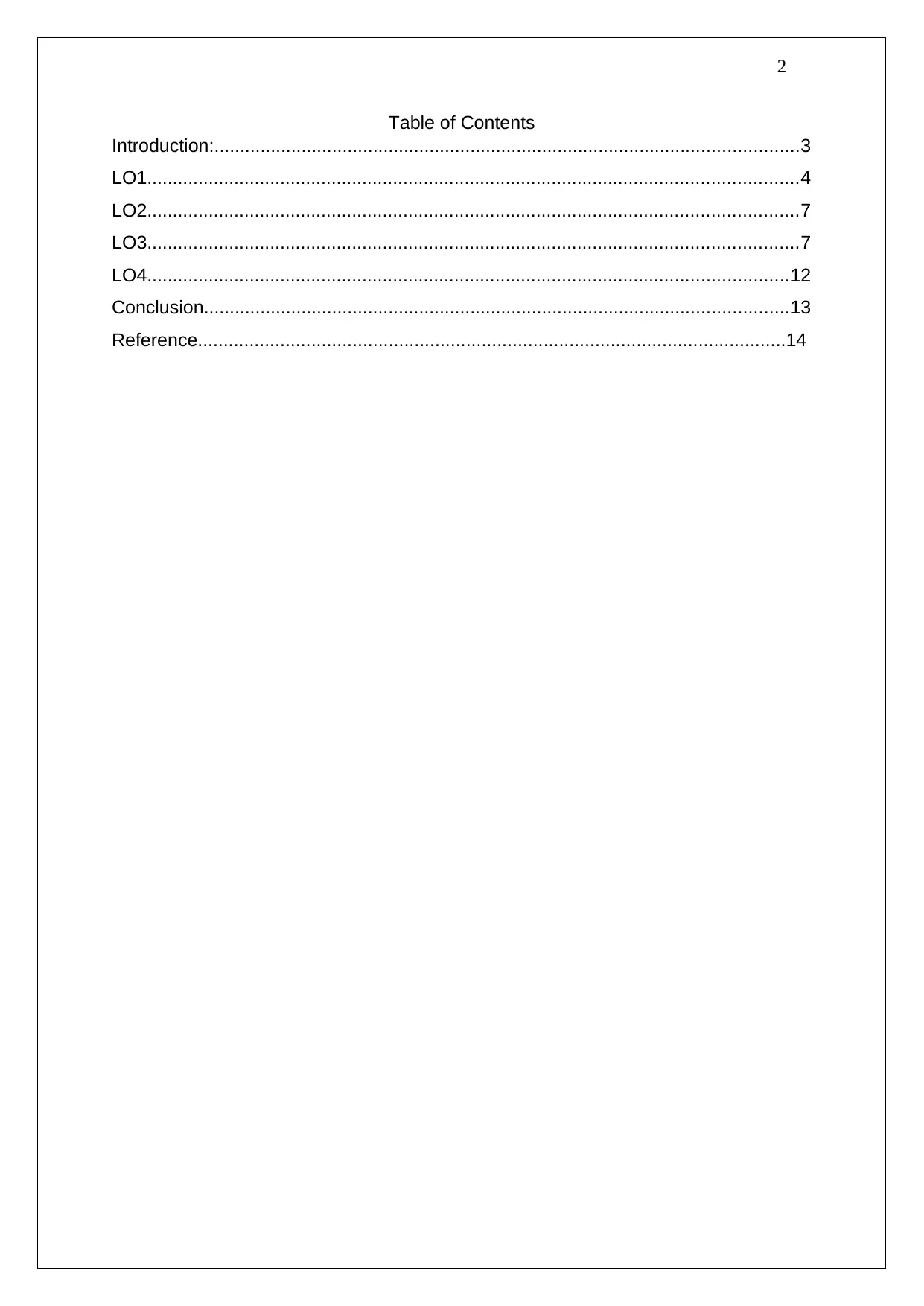
2
Table of Contents
Introduction:..................................................................................................................3
LO1...............................................................................................................................4
LO2...............................................................................................................................7
LO3...............................................................................................................................7
LO4.............................................................................................................................12
Conclusion..................................................................................................................13
Reference..................................................................................................................14
Table of Contents
Introduction:..................................................................................................................3
LO1...............................................................................................................................4
LO2...............................................................................................................................7
LO3...............................................................................................................................7
LO4.............................................................................................................................12
Conclusion..................................................................................................................13
Reference..................................................................................................................14
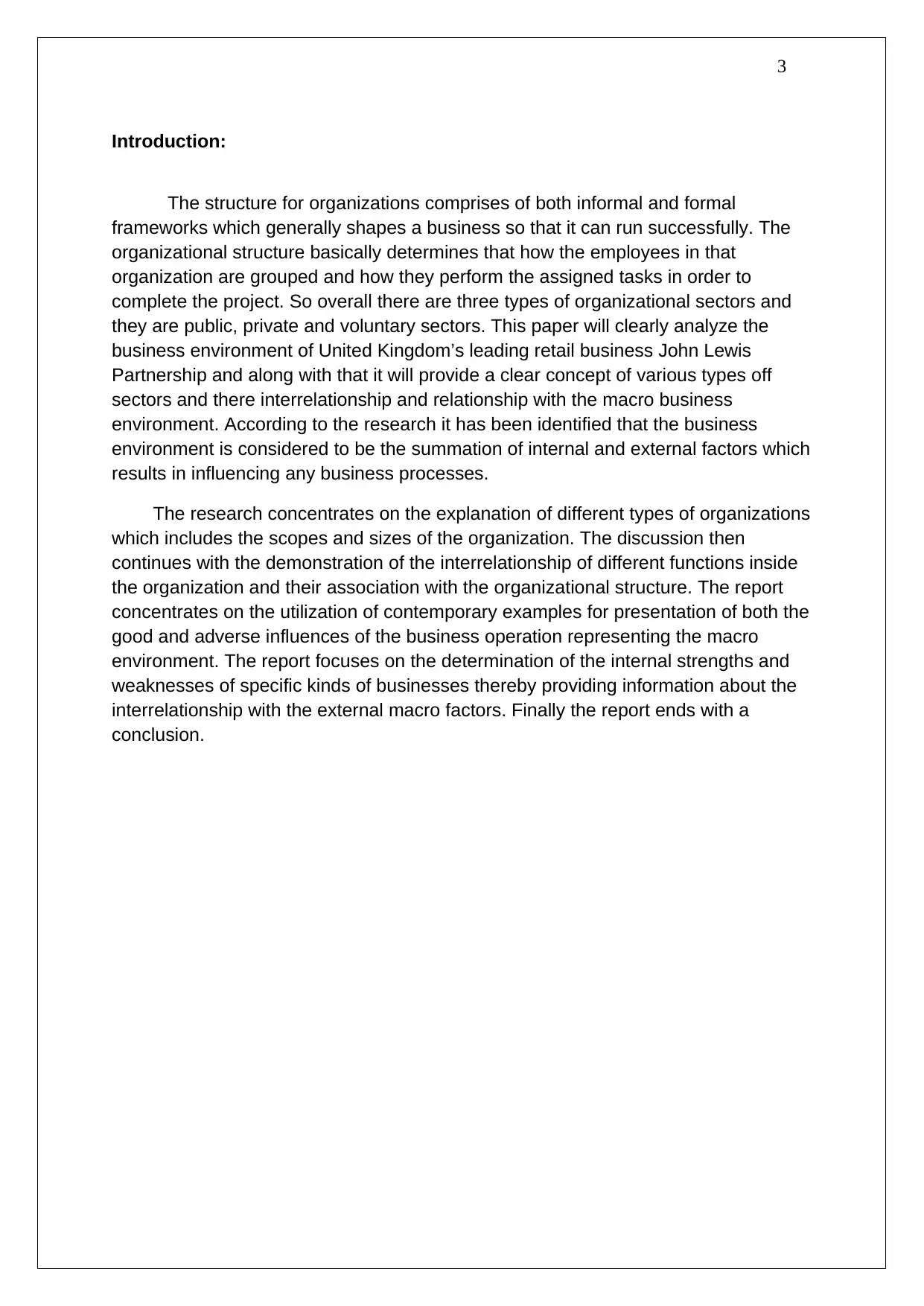
3
Introduction:
The structure for organizations comprises of both informal and formal
frameworks which generally shapes a business so that it can run successfully. The
organizational structure basically determines that how the employees in that
organization are grouped and how they perform the assigned tasks in order to
complete the project. So overall there are three types of organizational sectors and
they are public, private and voluntary sectors. This paper will clearly analyze the
business environment of United Kingdom’s leading retail business John Lewis
Partnership and along with that it will provide a clear concept of various types off
sectors and there interrelationship and relationship with the macro business
environment. According to the research it has been identified that the business
environment is considered to be the summation of internal and external factors which
results in influencing any business processes.
The research concentrates on the explanation of different types of organizations
which includes the scopes and sizes of the organization. The discussion then
continues with the demonstration of the interrelationship of different functions inside
the organization and their association with the organizational structure. The report
concentrates on the utilization of contemporary examples for presentation of both the
good and adverse influences of the business operation representing the macro
environment. The report focuses on the determination of the internal strengths and
weaknesses of specific kinds of businesses thereby providing information about the
interrelationship with the external macro factors. Finally the report ends with a
conclusion.
Introduction:
The structure for organizations comprises of both informal and formal
frameworks which generally shapes a business so that it can run successfully. The
organizational structure basically determines that how the employees in that
organization are grouped and how they perform the assigned tasks in order to
complete the project. So overall there are three types of organizational sectors and
they are public, private and voluntary sectors. This paper will clearly analyze the
business environment of United Kingdom’s leading retail business John Lewis
Partnership and along with that it will provide a clear concept of various types off
sectors and there interrelationship and relationship with the macro business
environment. According to the research it has been identified that the business
environment is considered to be the summation of internal and external factors which
results in influencing any business processes.
The research concentrates on the explanation of different types of organizations
which includes the scopes and sizes of the organization. The discussion then
continues with the demonstration of the interrelationship of different functions inside
the organization and their association with the organizational structure. The report
concentrates on the utilization of contemporary examples for presentation of both the
good and adverse influences of the business operation representing the macro
environment. The report focuses on the determination of the internal strengths and
weaknesses of specific kinds of businesses thereby providing information about the
interrelationship with the external macro factors. Finally the report ends with a
conclusion.
⊘ This is a preview!⊘
Do you want full access?
Subscribe today to unlock all pages.

Trusted by 1+ million students worldwide
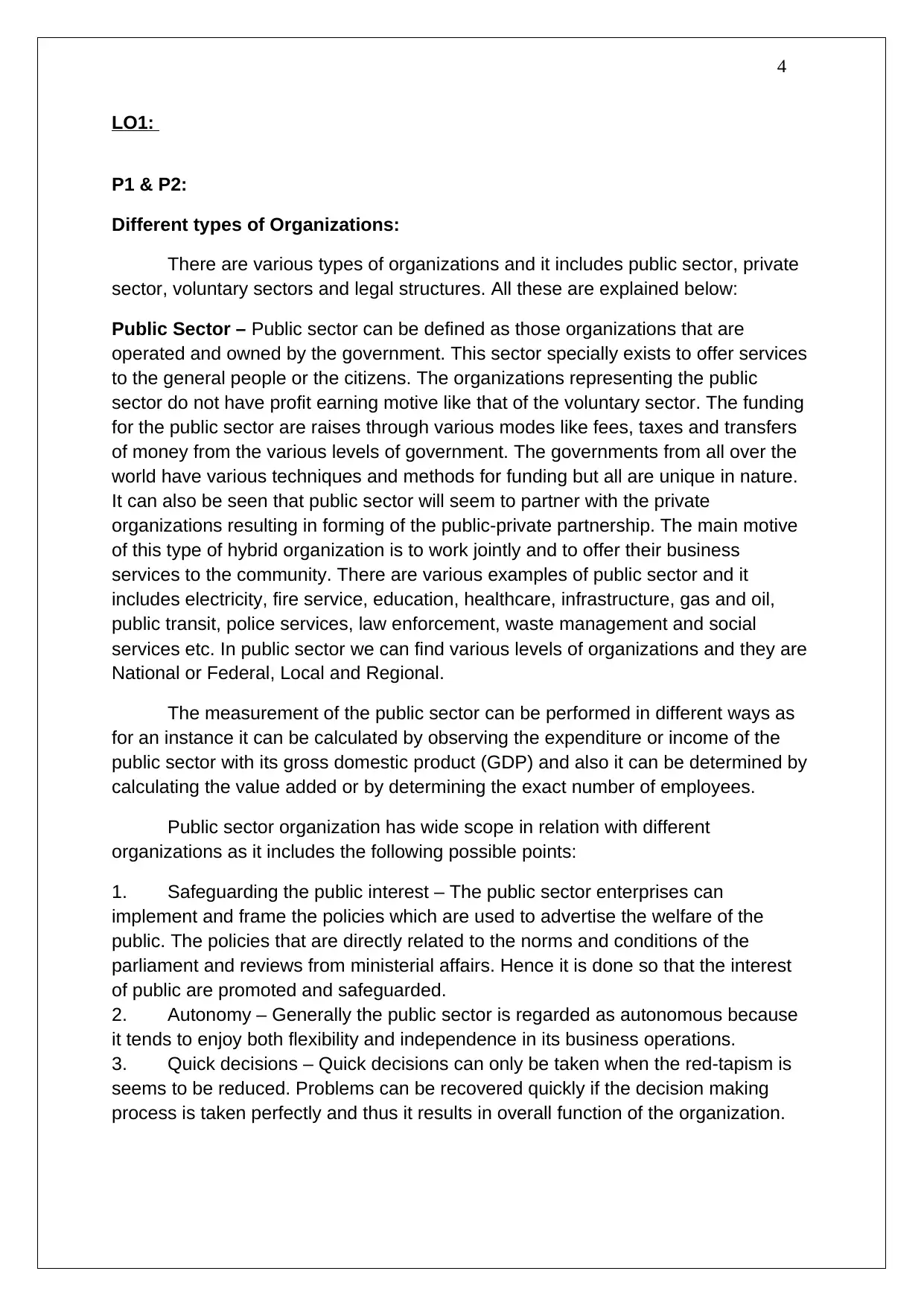
4
LO1:
P1 & P2:
Different types of Organizations:
There are various types of organizations and it includes public sector, private
sector, voluntary sectors and legal structures. All these are explained below:
Public Sector – Public sector can be defined as those organizations that are
operated and owned by the government. This sector specially exists to offer services
to the general people or the citizens. The organizations representing the public
sector do not have profit earning motive like that of the voluntary sector. The funding
for the public sector are raises through various modes like fees, taxes and transfers
of money from the various levels of government. The governments from all over the
world have various techniques and methods for funding but all are unique in nature.
It can also be seen that public sector will seem to partner with the private
organizations resulting in forming of the public-private partnership. The main motive
of this type of hybrid organization is to work jointly and to offer their business
services to the community. There are various examples of public sector and it
includes electricity, fire service, education, healthcare, infrastructure, gas and oil,
public transit, police services, law enforcement, waste management and social
services etc. In public sector we can find various levels of organizations and they are
National or Federal, Local and Regional.
The measurement of the public sector can be performed in different ways as
for an instance it can be calculated by observing the expenditure or income of the
public sector with its gross domestic product (GDP) and also it can be determined by
calculating the value added or by determining the exact number of employees.
Public sector organization has wide scope in relation with different
organizations as it includes the following possible points:
1. Safeguarding the public interest – The public sector enterprises can
implement and frame the policies which are used to advertise the welfare of the
public. The policies that are directly related to the norms and conditions of the
parliament and reviews from ministerial affairs. Hence it is done so that the interest
of public are promoted and safeguarded.
2. Autonomy – Generally the public sector is regarded as autonomous because
it tends to enjoy both flexibility and independence in its business operations.
3. Quick decisions – Quick decisions can only be taken when the red-tapism is
seems to be reduced. Problems can be recovered quickly if the decision making
process is taken perfectly and thus it results in overall function of the organization.
LO1:
P1 & P2:
Different types of Organizations:
There are various types of organizations and it includes public sector, private
sector, voluntary sectors and legal structures. All these are explained below:
Public Sector – Public sector can be defined as those organizations that are
operated and owned by the government. This sector specially exists to offer services
to the general people or the citizens. The organizations representing the public
sector do not have profit earning motive like that of the voluntary sector. The funding
for the public sector are raises through various modes like fees, taxes and transfers
of money from the various levels of government. The governments from all over the
world have various techniques and methods for funding but all are unique in nature.
It can also be seen that public sector will seem to partner with the private
organizations resulting in forming of the public-private partnership. The main motive
of this type of hybrid organization is to work jointly and to offer their business
services to the community. There are various examples of public sector and it
includes electricity, fire service, education, healthcare, infrastructure, gas and oil,
public transit, police services, law enforcement, waste management and social
services etc. In public sector we can find various levels of organizations and they are
National or Federal, Local and Regional.
The measurement of the public sector can be performed in different ways as
for an instance it can be calculated by observing the expenditure or income of the
public sector with its gross domestic product (GDP) and also it can be determined by
calculating the value added or by determining the exact number of employees.
Public sector organization has wide scope in relation with different
organizations as it includes the following possible points:
1. Safeguarding the public interest – The public sector enterprises can
implement and frame the policies which are used to advertise the welfare of the
public. The policies that are directly related to the norms and conditions of the
parliament and reviews from ministerial affairs. Hence it is done so that the interest
of public are promoted and safeguarded.
2. Autonomy – Generally the public sector is regarded as autonomous because
it tends to enjoy both flexibility and independence in its business operations.
3. Quick decisions – Quick decisions can only be taken when the red-tapism is
seems to be reduced. Problems can be recovered quickly if the decision making
process is taken perfectly and thus it results in overall function of the organization.
Paraphrase This Document
Need a fresh take? Get an instant paraphrase of this document with our AI Paraphraser
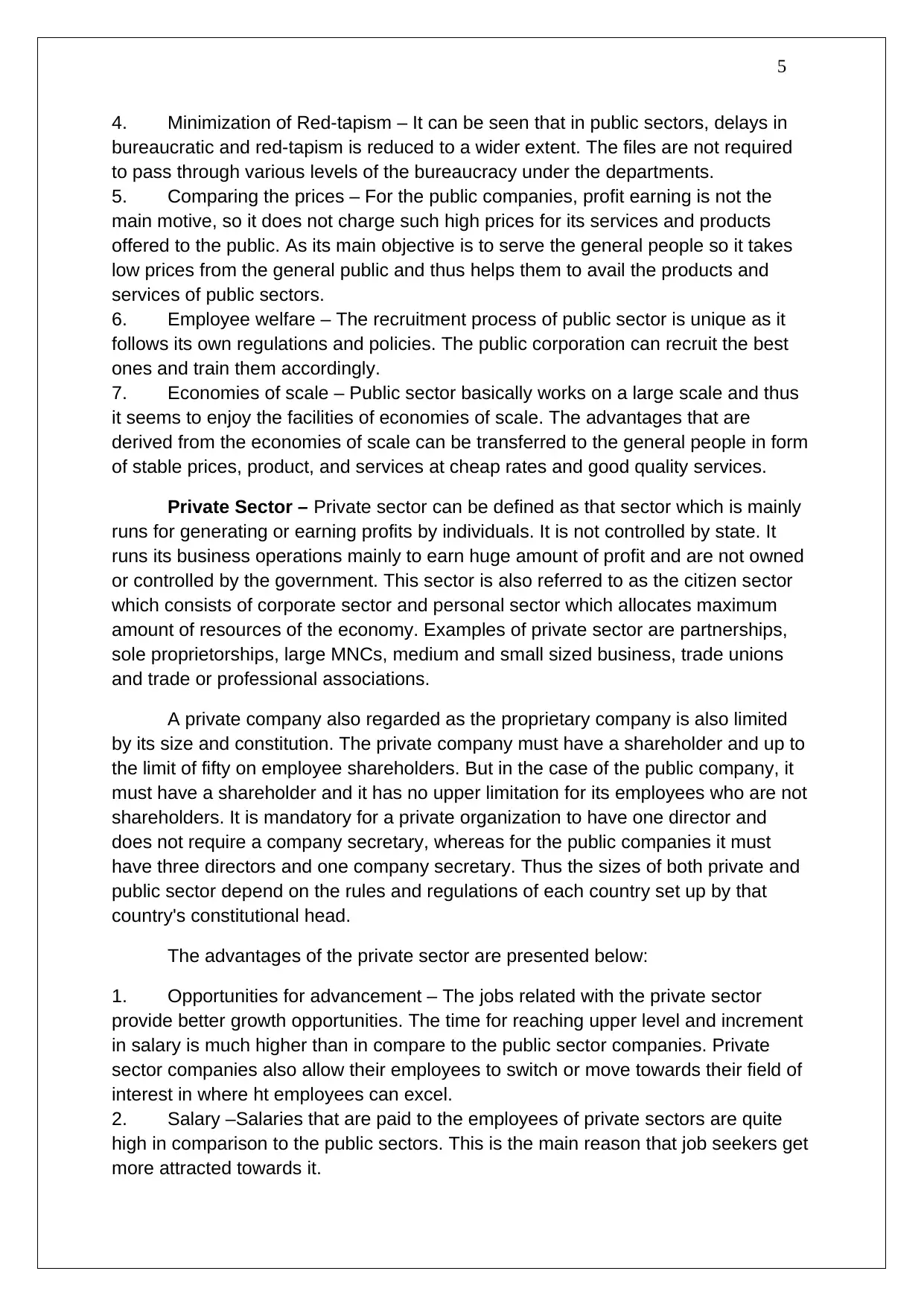
5
4. Minimization of Red-tapism – It can be seen that in public sectors, delays in
bureaucratic and red-tapism is reduced to a wider extent. The files are not required
to pass through various levels of the bureaucracy under the departments.
5. Comparing the prices – For the public companies, profit earning is not the
main motive, so it does not charge such high prices for its services and products
offered to the public. As its main objective is to serve the general people so it takes
low prices from the general public and thus helps them to avail the products and
services of public sectors.
6. Employee welfare – The recruitment process of public sector is unique as it
follows its own regulations and policies. The public corporation can recruit the best
ones and train them accordingly.
7. Economies of scale – Public sector basically works on a large scale and thus
it seems to enjoy the facilities of economies of scale. The advantages that are
derived from the economies of scale can be transferred to the general people in form
of stable prices, product, and services at cheap rates and good quality services.
Private Sector – Private sector can be defined as that sector which is mainly
runs for generating or earning profits by individuals. It is not controlled by state. It
runs its business operations mainly to earn huge amount of profit and are not owned
or controlled by the government. This sector is also referred to as the citizen sector
which consists of corporate sector and personal sector which allocates maximum
amount of resources of the economy. Examples of private sector are partnerships,
sole proprietorships, large MNCs, medium and small sized business, trade unions
and trade or professional associations.
A private company also regarded as the proprietary company is also limited
by its size and constitution. The private company must have a shareholder and up to
the limit of fifty on employee shareholders. But in the case of the public company, it
must have a shareholder and it has no upper limitation for its employees who are not
shareholders. It is mandatory for a private organization to have one director and
does not require a company secretary, whereas for the public companies it must
have three directors and one company secretary. Thus the sizes of both private and
public sector depend on the rules and regulations of each country set up by that
country's constitutional head.
The advantages of the private sector are presented below:
1. Opportunities for advancement – The jobs related with the private sector
provide better growth opportunities. The time for reaching upper level and increment
in salary is much higher than in compare to the public sector companies. Private
sector companies also allow their employees to switch or move towards their field of
interest in where ht employees can excel.
2. Salary –Salaries that are paid to the employees of private sectors are quite
high in comparison to the public sectors. This is the main reason that job seekers get
more attracted towards it.
4. Minimization of Red-tapism – It can be seen that in public sectors, delays in
bureaucratic and red-tapism is reduced to a wider extent. The files are not required
to pass through various levels of the bureaucracy under the departments.
5. Comparing the prices – For the public companies, profit earning is not the
main motive, so it does not charge such high prices for its services and products
offered to the public. As its main objective is to serve the general people so it takes
low prices from the general public and thus helps them to avail the products and
services of public sectors.
6. Employee welfare – The recruitment process of public sector is unique as it
follows its own regulations and policies. The public corporation can recruit the best
ones and train them accordingly.
7. Economies of scale – Public sector basically works on a large scale and thus
it seems to enjoy the facilities of economies of scale. The advantages that are
derived from the economies of scale can be transferred to the general people in form
of stable prices, product, and services at cheap rates and good quality services.
Private Sector – Private sector can be defined as that sector which is mainly
runs for generating or earning profits by individuals. It is not controlled by state. It
runs its business operations mainly to earn huge amount of profit and are not owned
or controlled by the government. This sector is also referred to as the citizen sector
which consists of corporate sector and personal sector which allocates maximum
amount of resources of the economy. Examples of private sector are partnerships,
sole proprietorships, large MNCs, medium and small sized business, trade unions
and trade or professional associations.
A private company also regarded as the proprietary company is also limited
by its size and constitution. The private company must have a shareholder and up to
the limit of fifty on employee shareholders. But in the case of the public company, it
must have a shareholder and it has no upper limitation for its employees who are not
shareholders. It is mandatory for a private organization to have one director and
does not require a company secretary, whereas for the public companies it must
have three directors and one company secretary. Thus the sizes of both private and
public sector depend on the rules and regulations of each country set up by that
country's constitutional head.
The advantages of the private sector are presented below:
1. Opportunities for advancement – The jobs related with the private sector
provide better growth opportunities. The time for reaching upper level and increment
in salary is much higher than in compare to the public sector companies. Private
sector companies also allow their employees to switch or move towards their field of
interest in where ht employees can excel.
2. Salary –Salaries that are paid to the employees of private sectors are quite
high in comparison to the public sectors. This is the main reason that job seekers get
more attracted towards it.
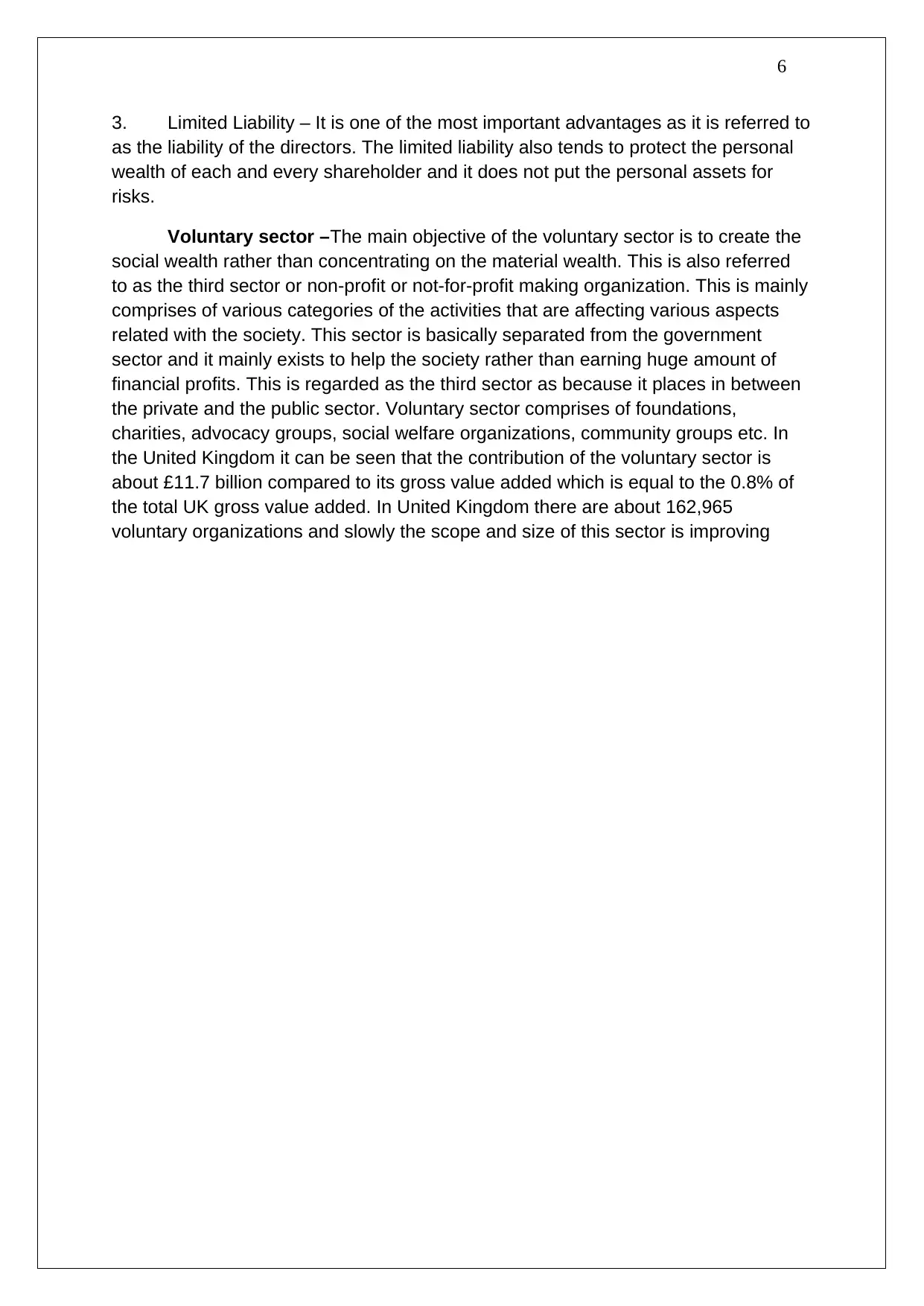
6
3. Limited Liability – It is one of the most important advantages as it is referred to
as the liability of the directors. The limited liability also tends to protect the personal
wealth of each and every shareholder and it does not put the personal assets for
risks.
Voluntary sector –The main objective of the voluntary sector is to create the
social wealth rather than concentrating on the material wealth. This is also referred
to as the third sector or non-profit or not-for-profit making organization. This is mainly
comprises of various categories of the activities that are affecting various aspects
related with the society. This sector is basically separated from the government
sector and it mainly exists to help the society rather than earning huge amount of
financial profits. This is regarded as the third sector as because it places in between
the private and the public sector. Voluntary sector comprises of foundations,
charities, advocacy groups, social welfare organizations, community groups etc. In
the United Kingdom it can be seen that the contribution of the voluntary sector is
about £11.7 billion compared to its gross value added which is equal to the 0.8% of
the total UK gross value added. In United Kingdom there are about 162,965
voluntary organizations and slowly the scope and size of this sector is improving
3. Limited Liability – It is one of the most important advantages as it is referred to
as the liability of the directors. The limited liability also tends to protect the personal
wealth of each and every shareholder and it does not put the personal assets for
risks.
Voluntary sector –The main objective of the voluntary sector is to create the
social wealth rather than concentrating on the material wealth. This is also referred
to as the third sector or non-profit or not-for-profit making organization. This is mainly
comprises of various categories of the activities that are affecting various aspects
related with the society. This sector is basically separated from the government
sector and it mainly exists to help the society rather than earning huge amount of
financial profits. This is regarded as the third sector as because it places in between
the private and the public sector. Voluntary sector comprises of foundations,
charities, advocacy groups, social welfare organizations, community groups etc. In
the United Kingdom it can be seen that the contribution of the voluntary sector is
about £11.7 billion compared to its gross value added which is equal to the 0.8% of
the total UK gross value added. In United Kingdom there are about 162,965
voluntary organizations and slowly the scope and size of this sector is improving
⊘ This is a preview!⊘
Do you want full access?
Subscribe today to unlock all pages.

Trusted by 1+ million students worldwide
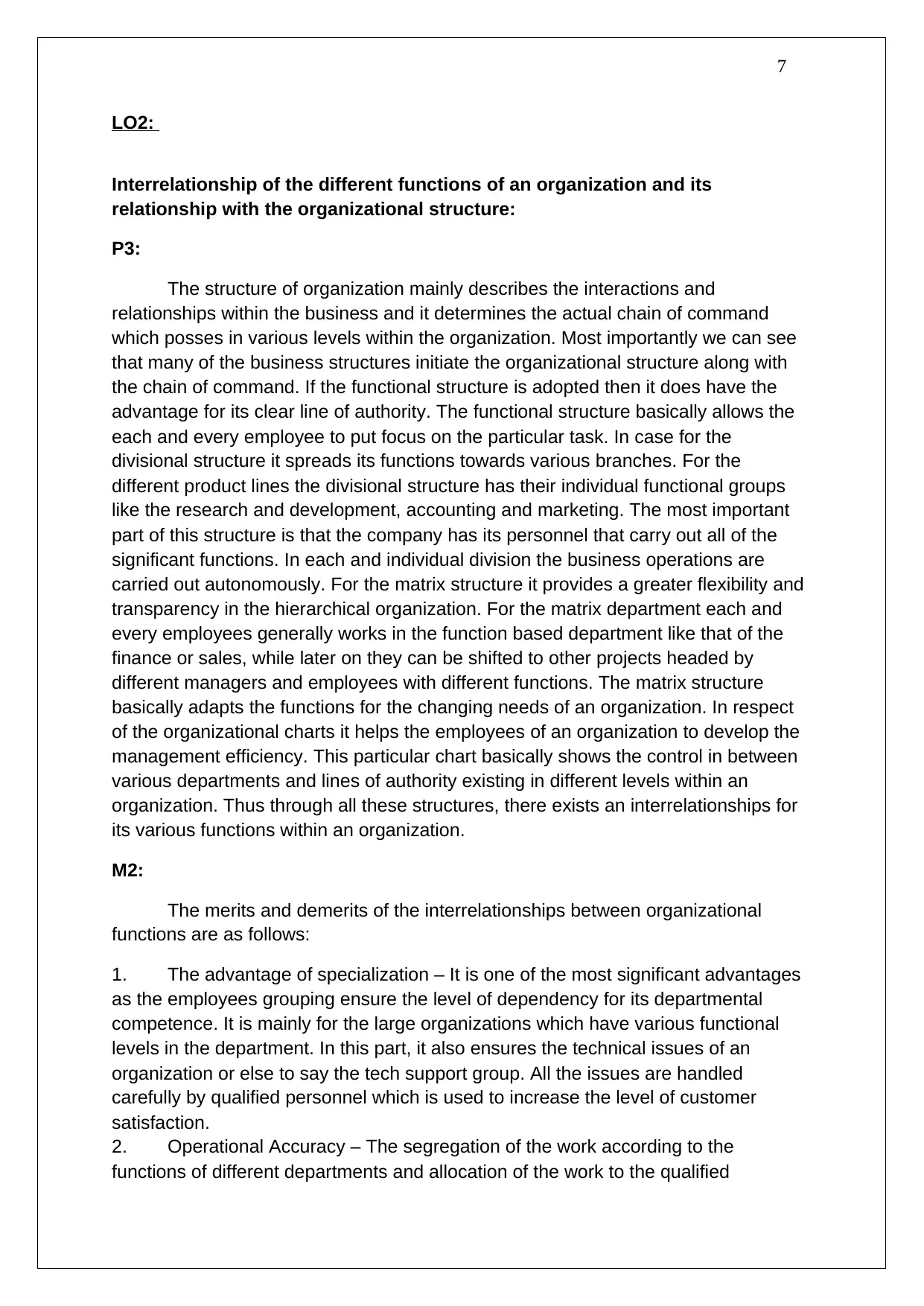
7
LO2:
Interrelationship of the different functions of an organization and its
relationship with the organizational structure:
P3:
The structure of organization mainly describes the interactions and
relationships within the business and it determines the actual chain of command
which posses in various levels within the organization. Most importantly we can see
that many of the business structures initiate the organizational structure along with
the chain of command. If the functional structure is adopted then it does have the
advantage for its clear line of authority. The functional structure basically allows the
each and every employee to put focus on the particular task. In case for the
divisional structure it spreads its functions towards various branches. For the
different product lines the divisional structure has their individual functional groups
like the research and development, accounting and marketing. The most important
part of this structure is that the company has its personnel that carry out all of the
significant functions. In each and individual division the business operations are
carried out autonomously. For the matrix structure it provides a greater flexibility and
transparency in the hierarchical organization. For the matrix department each and
every employees generally works in the function based department like that of the
finance or sales, while later on they can be shifted to other projects headed by
different managers and employees with different functions. The matrix structure
basically adapts the functions for the changing needs of an organization. In respect
of the organizational charts it helps the employees of an organization to develop the
management efficiency. This particular chart basically shows the control in between
various departments and lines of authority existing in different levels within an
organization. Thus through all these structures, there exists an interrelationships for
its various functions within an organization.
M2:
The merits and demerits of the interrelationships between organizational
functions are as follows:
1. The advantage of specialization – It is one of the most significant advantages
as the employees grouping ensure the level of dependency for its departmental
competence. It is mainly for the large organizations which have various functional
levels in the department. In this part, it also ensures the technical issues of an
organization or else to say the tech support group. All the issues are handled
carefully by qualified personnel which is used to increase the level of customer
satisfaction.
2. Operational Accuracy – The segregation of the work according to the
functions of different departments and allocation of the work to the qualified
LO2:
Interrelationship of the different functions of an organization and its
relationship with the organizational structure:
P3:
The structure of organization mainly describes the interactions and
relationships within the business and it determines the actual chain of command
which posses in various levels within the organization. Most importantly we can see
that many of the business structures initiate the organizational structure along with
the chain of command. If the functional structure is adopted then it does have the
advantage for its clear line of authority. The functional structure basically allows the
each and every employee to put focus on the particular task. In case for the
divisional structure it spreads its functions towards various branches. For the
different product lines the divisional structure has their individual functional groups
like the research and development, accounting and marketing. The most important
part of this structure is that the company has its personnel that carry out all of the
significant functions. In each and individual division the business operations are
carried out autonomously. For the matrix structure it provides a greater flexibility and
transparency in the hierarchical organization. For the matrix department each and
every employees generally works in the function based department like that of the
finance or sales, while later on they can be shifted to other projects headed by
different managers and employees with different functions. The matrix structure
basically adapts the functions for the changing needs of an organization. In respect
of the organizational charts it helps the employees of an organization to develop the
management efficiency. This particular chart basically shows the control in between
various departments and lines of authority existing in different levels within an
organization. Thus through all these structures, there exists an interrelationships for
its various functions within an organization.
M2:
The merits and demerits of the interrelationships between organizational
functions are as follows:
1. The advantage of specialization – It is one of the most significant advantages
as the employees grouping ensure the level of dependency for its departmental
competence. It is mainly for the large organizations which have various functional
levels in the department. In this part, it also ensures the technical issues of an
organization or else to say the tech support group. All the issues are handled
carefully by qualified personnel which is used to increase the level of customer
satisfaction.
2. Operational Accuracy – The segregation of the work according to the
functions of different departments and allocation of the work to the qualified
Paraphrase This Document
Need a fresh take? Get an instant paraphrase of this document with our AI Paraphraser
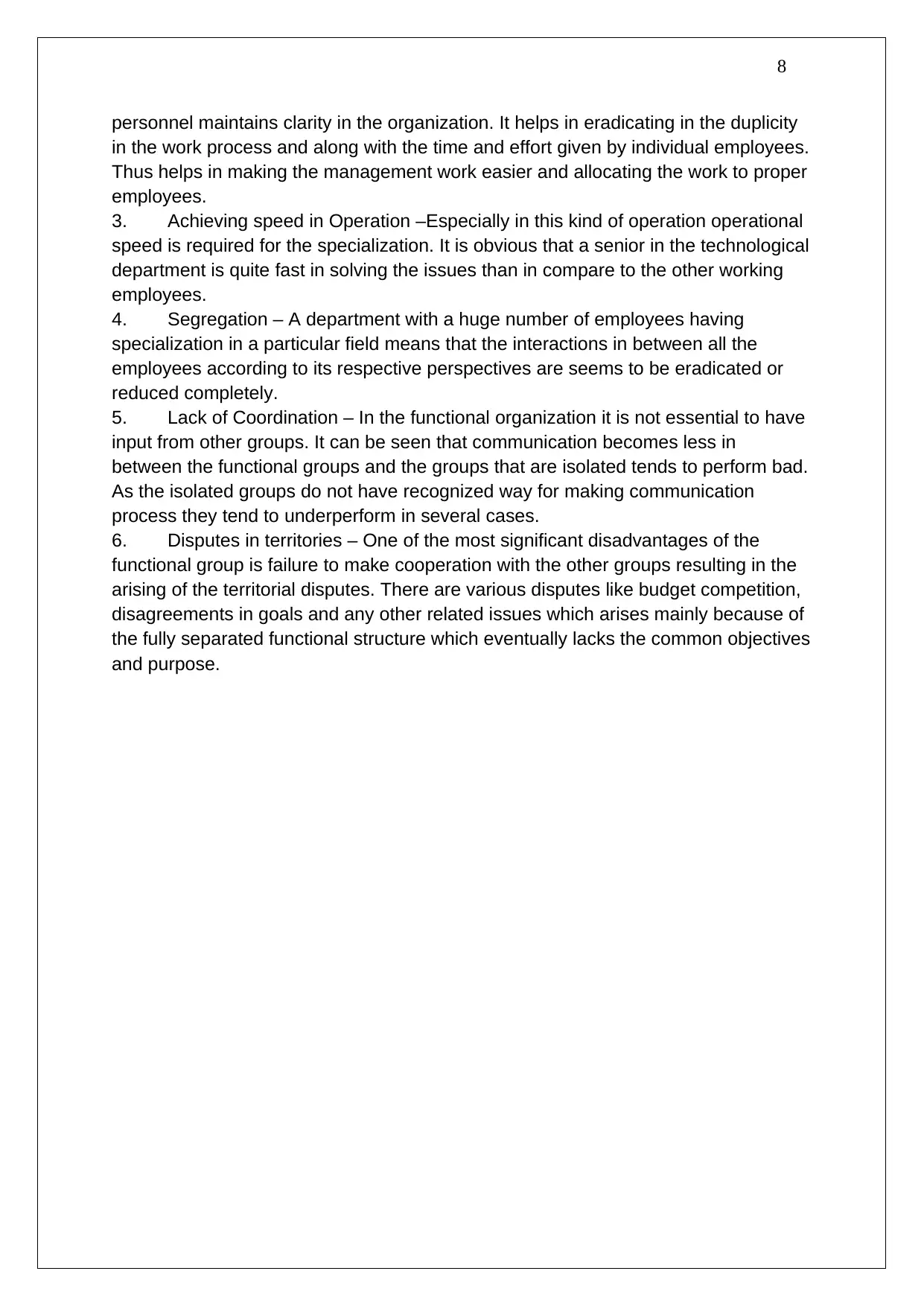
8
personnel maintains clarity in the organization. It helps in eradicating in the duplicity
in the work process and along with the time and effort given by individual employees.
Thus helps in making the management work easier and allocating the work to proper
employees.
3. Achieving speed in Operation –Especially in this kind of operation operational
speed is required for the specialization. It is obvious that a senior in the technological
department is quite fast in solving the issues than in compare to the other working
employees.
4. Segregation – A department with a huge number of employees having
specialization in a particular field means that the interactions in between all the
employees according to its respective perspectives are seems to be eradicated or
reduced completely.
5. Lack of Coordination – In the functional organization it is not essential to have
input from other groups. It can be seen that communication becomes less in
between the functional groups and the groups that are isolated tends to perform bad.
As the isolated groups do not have recognized way for making communication
process they tend to underperform in several cases.
6. Disputes in territories – One of the most significant disadvantages of the
functional group is failure to make cooperation with the other groups resulting in the
arising of the territorial disputes. There are various disputes like budget competition,
disagreements in goals and any other related issues which arises mainly because of
the fully separated functional structure which eventually lacks the common objectives
and purpose.
personnel maintains clarity in the organization. It helps in eradicating in the duplicity
in the work process and along with the time and effort given by individual employees.
Thus helps in making the management work easier and allocating the work to proper
employees.
3. Achieving speed in Operation –Especially in this kind of operation operational
speed is required for the specialization. It is obvious that a senior in the technological
department is quite fast in solving the issues than in compare to the other working
employees.
4. Segregation – A department with a huge number of employees having
specialization in a particular field means that the interactions in between all the
employees according to its respective perspectives are seems to be eradicated or
reduced completely.
5. Lack of Coordination – In the functional organization it is not essential to have
input from other groups. It can be seen that communication becomes less in
between the functional groups and the groups that are isolated tends to perform bad.
As the isolated groups do not have recognized way for making communication
process they tend to underperform in several cases.
6. Disputes in territories – One of the most significant disadvantages of the
functional group is failure to make cooperation with the other groups resulting in the
arising of the territorial disputes. There are various disputes like budget competition,
disagreements in goals and any other related issues which arises mainly because of
the fully separated functional structure which eventually lacks the common objectives
and purpose.
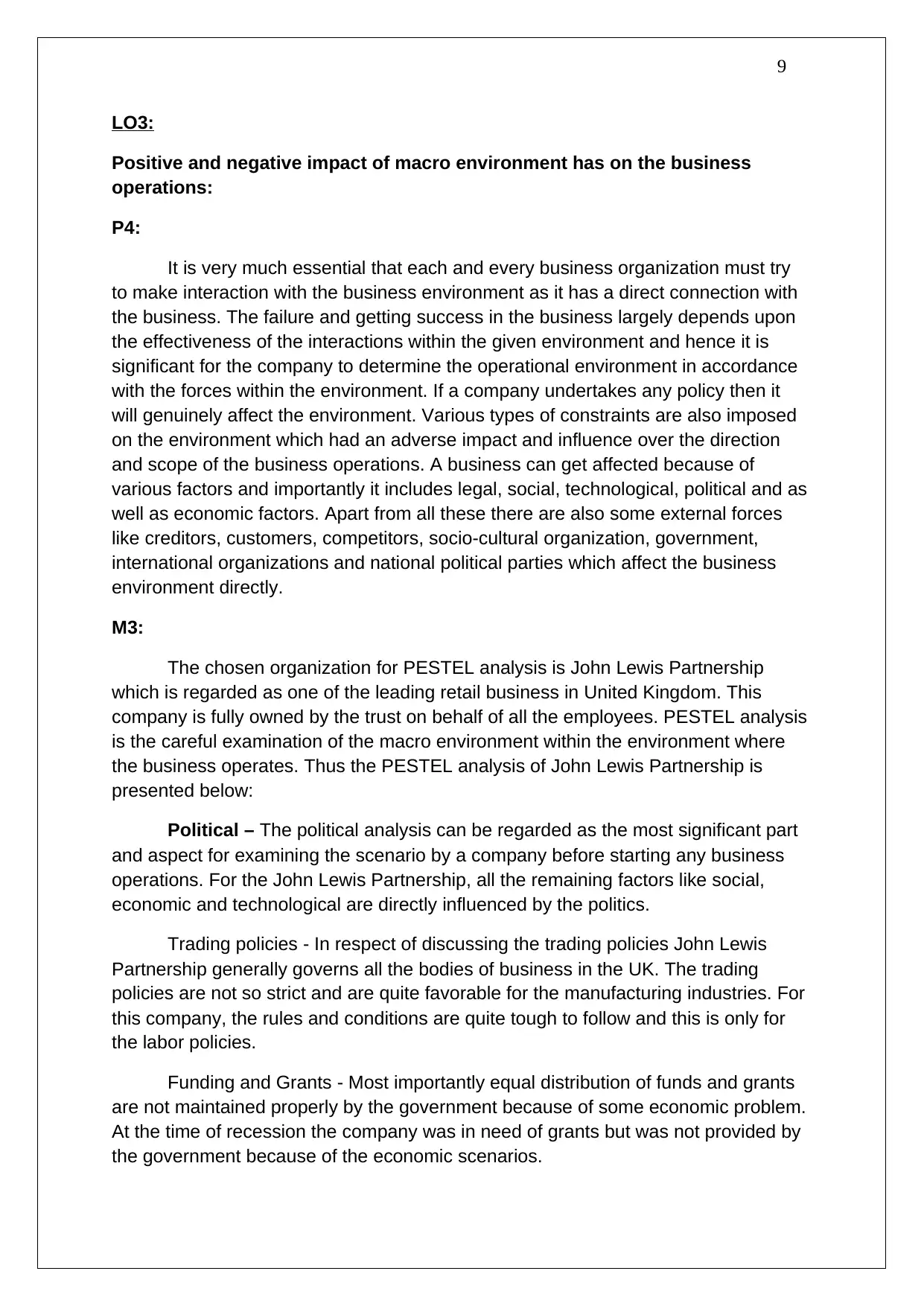
9
LO3:
Positive and negative impact of macro environment has on the business
operations:
P4:
It is very much essential that each and every business organization must try
to make interaction with the business environment as it has a direct connection with
the business. The failure and getting success in the business largely depends upon
the effectiveness of the interactions within the given environment and hence it is
significant for the company to determine the operational environment in accordance
with the forces within the environment. If a company undertakes any policy then it
will genuinely affect the environment. Various types of constraints are also imposed
on the environment which had an adverse impact and influence over the direction
and scope of the business operations. A business can get affected because of
various factors and importantly it includes legal, social, technological, political and as
well as economic factors. Apart from all these there are also some external forces
like creditors, customers, competitors, socio-cultural organization, government,
international organizations and national political parties which affect the business
environment directly.
M3:
The chosen organization for PESTEL analysis is John Lewis Partnership
which is regarded as one of the leading retail business in United Kingdom. This
company is fully owned by the trust on behalf of all the employees. PESTEL analysis
is the careful examination of the macro environment within the environment where
the business operates. Thus the PESTEL analysis of John Lewis Partnership is
presented below:
Political – The political analysis can be regarded as the most significant part
and aspect for examining the scenario by a company before starting any business
operations. For the John Lewis Partnership, all the remaining factors like social,
economic and technological are directly influenced by the politics.
Trading policies - In respect of discussing the trading policies John Lewis
Partnership generally governs all the bodies of business in the UK. The trading
policies are not so strict and are quite favorable for the manufacturing industries. For
this company, the rules and conditions are quite tough to follow and this is only for
the labor policies.
Funding and Grants - Most importantly equal distribution of funds and grants
are not maintained properly by the government because of some economic problem.
At the time of recession the company was in need of grants but was not provided by
the government because of the economic scenarios.
LO3:
Positive and negative impact of macro environment has on the business
operations:
P4:
It is very much essential that each and every business organization must try
to make interaction with the business environment as it has a direct connection with
the business. The failure and getting success in the business largely depends upon
the effectiveness of the interactions within the given environment and hence it is
significant for the company to determine the operational environment in accordance
with the forces within the environment. If a company undertakes any policy then it
will genuinely affect the environment. Various types of constraints are also imposed
on the environment which had an adverse impact and influence over the direction
and scope of the business operations. A business can get affected because of
various factors and importantly it includes legal, social, technological, political and as
well as economic factors. Apart from all these there are also some external forces
like creditors, customers, competitors, socio-cultural organization, government,
international organizations and national political parties which affect the business
environment directly.
M3:
The chosen organization for PESTEL analysis is John Lewis Partnership
which is regarded as one of the leading retail business in United Kingdom. This
company is fully owned by the trust on behalf of all the employees. PESTEL analysis
is the careful examination of the macro environment within the environment where
the business operates. Thus the PESTEL analysis of John Lewis Partnership is
presented below:
Political – The political analysis can be regarded as the most significant part
and aspect for examining the scenario by a company before starting any business
operations. For the John Lewis Partnership, all the remaining factors like social,
economic and technological are directly influenced by the politics.
Trading policies - In respect of discussing the trading policies John Lewis
Partnership generally governs all the bodies of business in the UK. The trading
policies are not so strict and are quite favorable for the manufacturing industries. For
this company, the rules and conditions are quite tough to follow and this is only for
the labor policies.
Funding and Grants - Most importantly equal distribution of funds and grants
are not maintained properly by the government because of some economic problem.
At the time of recession the company was in need of grants but was not provided by
the government because of the economic scenarios.
⊘ This is a preview!⊘
Do you want full access?
Subscribe today to unlock all pages.

Trusted by 1+ million students worldwide
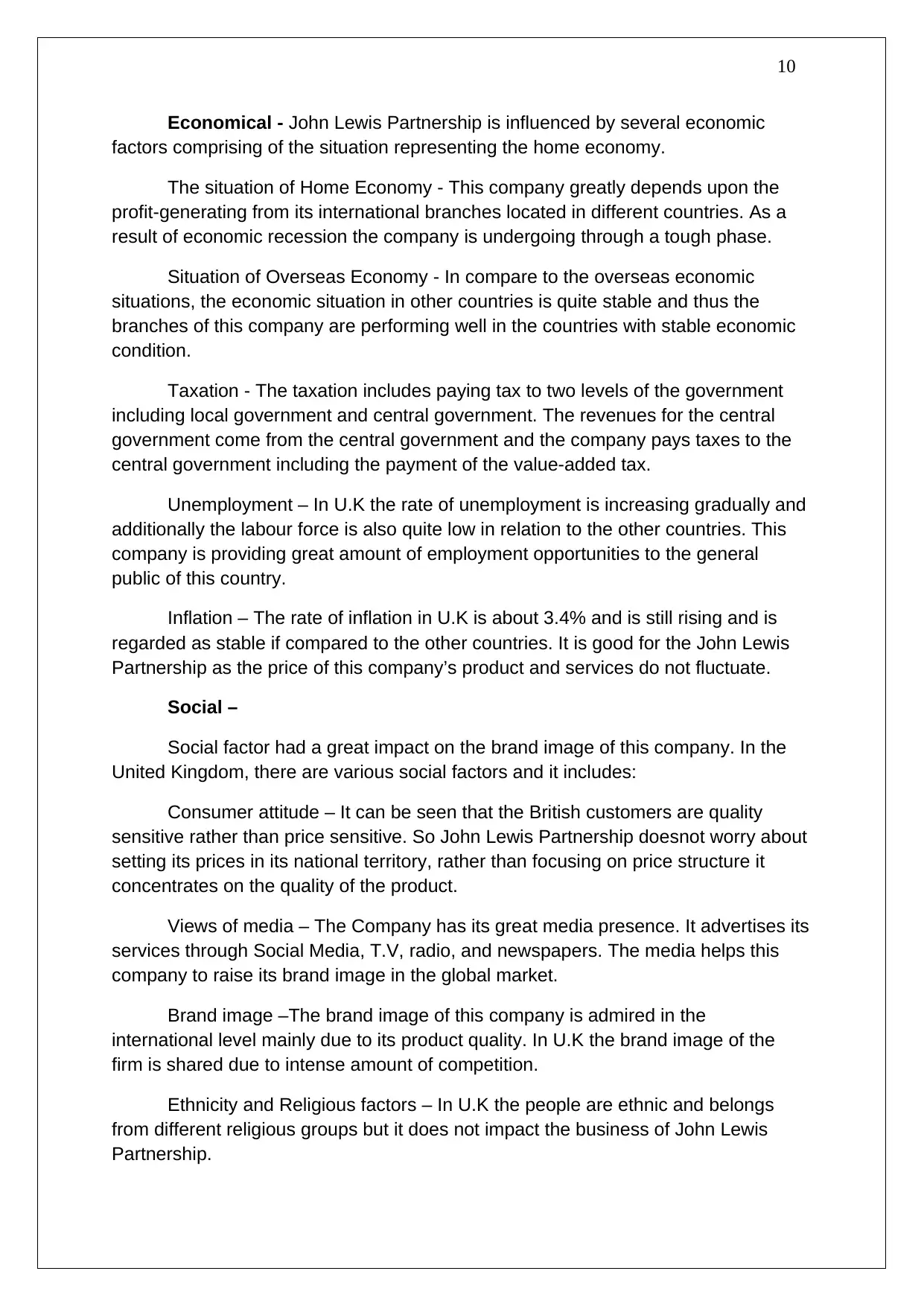
10
Economical - John Lewis Partnership is influenced by several economic
factors comprising of the situation representing the home economy.
The situation of Home Economy - This company greatly depends upon the
profit-generating from its international branches located in different countries. As a
result of economic recession the company is undergoing through a tough phase.
Situation of Overseas Economy - In compare to the overseas economic
situations, the economic situation in other countries is quite stable and thus the
branches of this company are performing well in the countries with stable economic
condition.
Taxation - The taxation includes paying tax to two levels of the government
including local government and central government. The revenues for the central
government come from the central government and the company pays taxes to the
central government including the payment of the value-added tax.
Unemployment – In U.K the rate of unemployment is increasing gradually and
additionally the labour force is also quite low in relation to the other countries. This
company is providing great amount of employment opportunities to the general
public of this country.
Inflation – The rate of inflation in U.K is about 3.4% and is still rising and is
regarded as stable if compared to the other countries. It is good for the John Lewis
Partnership as the price of this company’s product and services do not fluctuate.
Social –
Social factor had a great impact on the brand image of this company. In the
United Kingdom, there are various social factors and it includes:
Consumer attitude – It can be seen that the British customers are quality
sensitive rather than price sensitive. So John Lewis Partnership doesnot worry about
setting its prices in its national territory, rather than focusing on price structure it
concentrates on the quality of the product.
Views of media – The Company has its great media presence. It advertises its
services through Social Media, T.V, radio, and newspapers. The media helps this
company to raise its brand image in the global market.
Brand image –The brand image of this company is admired in the
international level mainly due to its product quality. In U.K the brand image of the
firm is shared due to intense amount of competition.
Ethnicity and Religious factors – In U.K the people are ethnic and belongs
from different religious groups but it does not impact the business of John Lewis
Partnership.
Economical - John Lewis Partnership is influenced by several economic
factors comprising of the situation representing the home economy.
The situation of Home Economy - This company greatly depends upon the
profit-generating from its international branches located in different countries. As a
result of economic recession the company is undergoing through a tough phase.
Situation of Overseas Economy - In compare to the overseas economic
situations, the economic situation in other countries is quite stable and thus the
branches of this company are performing well in the countries with stable economic
condition.
Taxation - The taxation includes paying tax to two levels of the government
including local government and central government. The revenues for the central
government come from the central government and the company pays taxes to the
central government including the payment of the value-added tax.
Unemployment – In U.K the rate of unemployment is increasing gradually and
additionally the labour force is also quite low in relation to the other countries. This
company is providing great amount of employment opportunities to the general
public of this country.
Inflation – The rate of inflation in U.K is about 3.4% and is still rising and is
regarded as stable if compared to the other countries. It is good for the John Lewis
Partnership as the price of this company’s product and services do not fluctuate.
Social –
Social factor had a great impact on the brand image of this company. In the
United Kingdom, there are various social factors and it includes:
Consumer attitude – It can be seen that the British customers are quality
sensitive rather than price sensitive. So John Lewis Partnership doesnot worry about
setting its prices in its national territory, rather than focusing on price structure it
concentrates on the quality of the product.
Views of media – The Company has its great media presence. It advertises its
services through Social Media, T.V, radio, and newspapers. The media helps this
company to raise its brand image in the global market.
Brand image –The brand image of this company is admired in the
international level mainly due to its product quality. In U.K the brand image of the
firm is shared due to intense amount of competition.
Ethnicity and Religious factors – In U.K the people are ethnic and belongs
from different religious groups but it does not impact the business of John Lewis
Partnership.
Paraphrase This Document
Need a fresh take? Get an instant paraphrase of this document with our AI Paraphraser
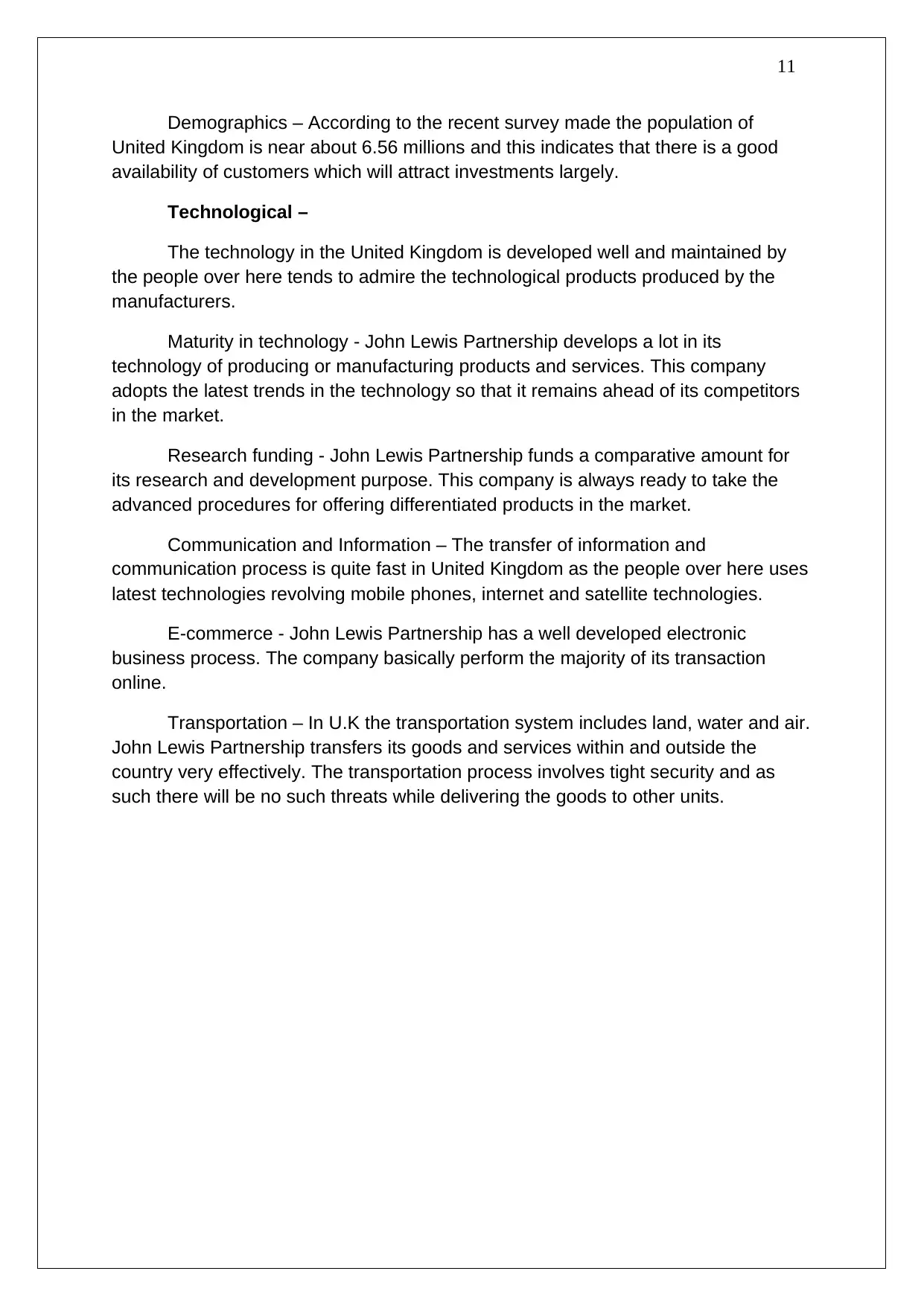
11
Demographics – According to the recent survey made the population of
United Kingdom is near about 6.56 millions and this indicates that there is a good
availability of customers which will attract investments largely.
Technological –
The technology in the United Kingdom is developed well and maintained by
the people over here tends to admire the technological products produced by the
manufacturers.
Maturity in technology - John Lewis Partnership develops a lot in its
technology of producing or manufacturing products and services. This company
adopts the latest trends in the technology so that it remains ahead of its competitors
in the market.
Research funding - John Lewis Partnership funds a comparative amount for
its research and development purpose. This company is always ready to take the
advanced procedures for offering differentiated products in the market.
Communication and Information – The transfer of information and
communication process is quite fast in United Kingdom as the people over here uses
latest technologies revolving mobile phones, internet and satellite technologies.
E-commerce - John Lewis Partnership has a well developed electronic
business process. The company basically perform the majority of its transaction
online.
Transportation – In U.K the transportation system includes land, water and air.
John Lewis Partnership transfers its goods and services within and outside the
country very effectively. The transportation process involves tight security and as
such there will be no such threats while delivering the goods to other units.
Demographics – According to the recent survey made the population of
United Kingdom is near about 6.56 millions and this indicates that there is a good
availability of customers which will attract investments largely.
Technological –
The technology in the United Kingdom is developed well and maintained by
the people over here tends to admire the technological products produced by the
manufacturers.
Maturity in technology - John Lewis Partnership develops a lot in its
technology of producing or manufacturing products and services. This company
adopts the latest trends in the technology so that it remains ahead of its competitors
in the market.
Research funding - John Lewis Partnership funds a comparative amount for
its research and development purpose. This company is always ready to take the
advanced procedures for offering differentiated products in the market.
Communication and Information – The transfer of information and
communication process is quite fast in United Kingdom as the people over here uses
latest technologies revolving mobile phones, internet and satellite technologies.
E-commerce - John Lewis Partnership has a well developed electronic
business process. The company basically perform the majority of its transaction
online.
Transportation – In U.K the transportation system includes land, water and air.
John Lewis Partnership transfers its goods and services within and outside the
country very effectively. The transportation process involves tight security and as
such there will be no such threats while delivering the goods to other units.
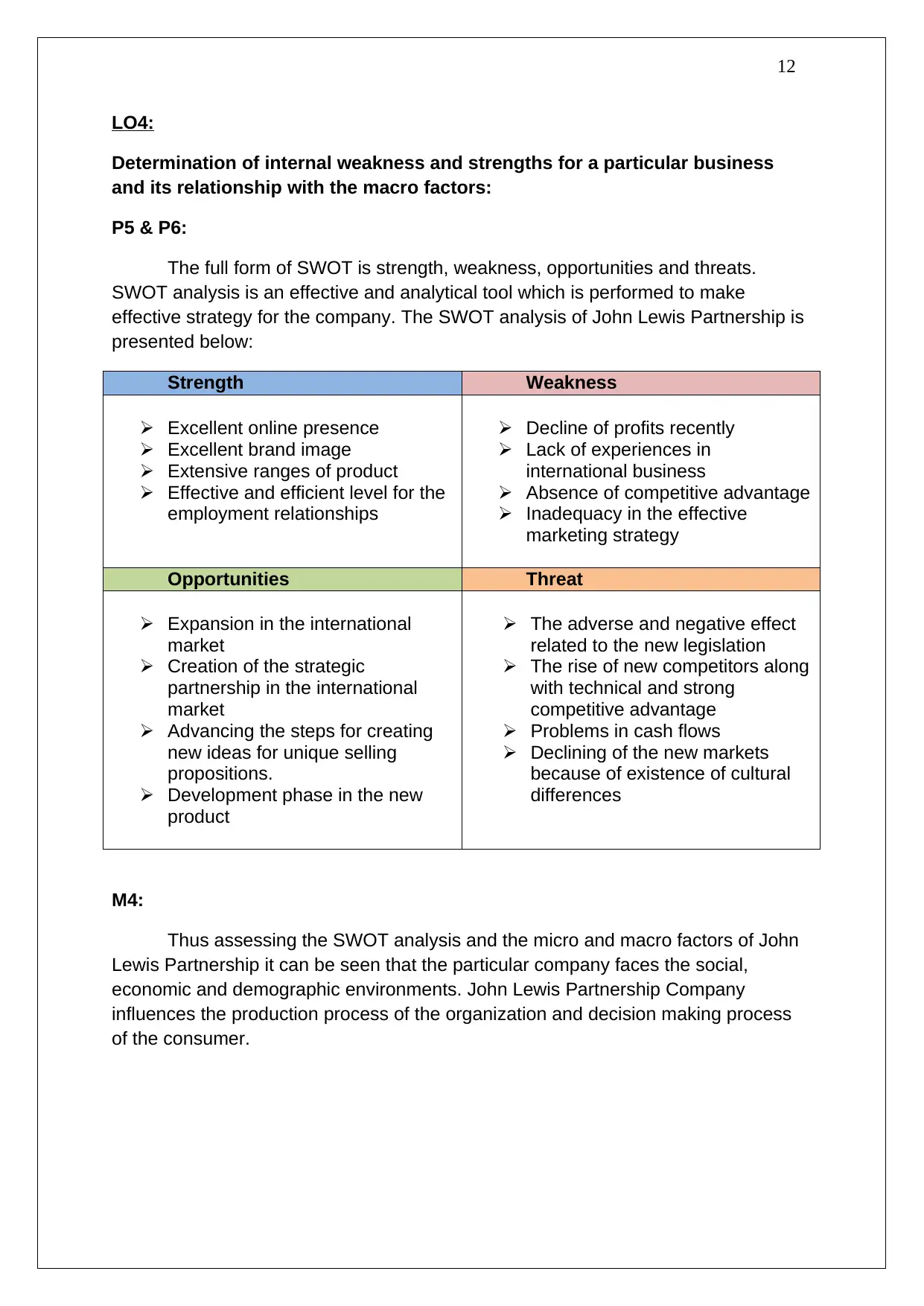
12
LO4:
Determination of internal weakness and strengths for a particular business
and its relationship with the macro factors:
P5 & P6:
The full form of SWOT is strength, weakness, opportunities and threats.
SWOT analysis is an effective and analytical tool which is performed to make
effective strategy for the company. The SWOT analysis of John Lewis Partnership is
presented below:
Strength Weakness
Excellent online presence
Excellent brand image
Extensive ranges of product
Effective and efficient level for the
employment relationships
Decline of profits recently
Lack of experiences in
international business
Absence of competitive advantage
Inadequacy in the effective
marketing strategy
Opportunities Threat
Expansion in the international
market
Creation of the strategic
partnership in the international
market
Advancing the steps for creating
new ideas for unique selling
propositions.
Development phase in the new
product
The adverse and negative effect
related to the new legislation
The rise of new competitors along
with technical and strong
competitive advantage
Problems in cash flows
Declining of the new markets
because of existence of cultural
differences
M4:
Thus assessing the SWOT analysis and the micro and macro factors of John
Lewis Partnership it can be seen that the particular company faces the social,
economic and demographic environments. John Lewis Partnership Company
influences the production process of the organization and decision making process
of the consumer.
LO4:
Determination of internal weakness and strengths for a particular business
and its relationship with the macro factors:
P5 & P6:
The full form of SWOT is strength, weakness, opportunities and threats.
SWOT analysis is an effective and analytical tool which is performed to make
effective strategy for the company. The SWOT analysis of John Lewis Partnership is
presented below:
Strength Weakness
Excellent online presence
Excellent brand image
Extensive ranges of product
Effective and efficient level for the
employment relationships
Decline of profits recently
Lack of experiences in
international business
Absence of competitive advantage
Inadequacy in the effective
marketing strategy
Opportunities Threat
Expansion in the international
market
Creation of the strategic
partnership in the international
market
Advancing the steps for creating
new ideas for unique selling
propositions.
Development phase in the new
product
The adverse and negative effect
related to the new legislation
The rise of new competitors along
with technical and strong
competitive advantage
Problems in cash flows
Declining of the new markets
because of existence of cultural
differences
M4:
Thus assessing the SWOT analysis and the micro and macro factors of John
Lewis Partnership it can be seen that the particular company faces the social,
economic and demographic environments. John Lewis Partnership Company
influences the production process of the organization and decision making process
of the consumer.
⊘ This is a preview!⊘
Do you want full access?
Subscribe today to unlock all pages.

Trusted by 1+ million students worldwide
1 out of 14
Related Documents
Your All-in-One AI-Powered Toolkit for Academic Success.
+13062052269
info@desklib.com
Available 24*7 on WhatsApp / Email
![[object Object]](/_next/static/media/star-bottom.7253800d.svg)
Unlock your academic potential
Copyright © 2020–2025 A2Z Services. All Rights Reserved. Developed and managed by ZUCOL.



